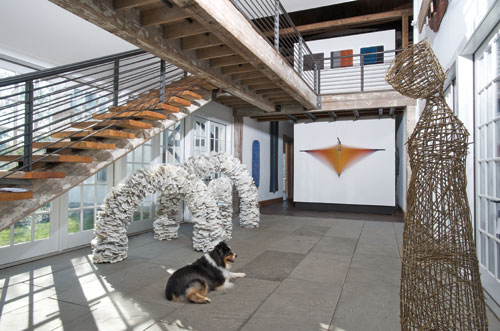We’ve had a busy fall season at browngrotta arts. First was Stimulus: art and its inception, which you can still see in the catalog http://www.
browngrotta.com/Pages/c36.php and online through the end of the month http://www.browngrotta.com/Pages/StimulusOnlineExhibit.php. Next up, is Green from the Get Go: International Contemporary Basketmakers at the Wayne Art Center, Pennsylvania http://www.
wayneart.org/exhibition/green-from-the-get-go-international-contemporary-basketmakers which runs from December 2, 2011 to January 21, 2012. Green from the Get Go is curated by Jane Milosch, former curator of the Renwick Gallery, Smithsonian American Art Museum in collaboration with browngrotta arts. The exhibition features an exciting compilation of more than 40 works by artists who take inspiration from nature and the history of basketry. Since prehistoric times artists and craftspeople have been highly attuned to the beauty and resources of the natural world, whether depicting a pristine landscape, untouched by man, or harvesting plants and minerals for pigments and brushes. Sustainability is part of the design and craft process, which requires a heightened sensitivity to materials, one that honors the caring for, replenishing and repurposing of materials. Artist Dorothy Gill Barnes captures this eco-friendly position well when she explains, “my intent is to construct a vessel or related object using materials respectfully harvested from nature.”

CROSSING OVER Dona Anderson bamboo kendo (martial art sticks), patterned paper, thread 15″ x 94″ x 30″ 2008. photo by Richard Nicol
Some of the sculptural baskets in Green from the Get Go are made from both flora and fauna, from bamboo, pine, sea grass, and willow to emu feathers and bayberry thorns. The tactile nature of these fiberous works stimulates all of the senses—sight, smell, touch and even sound. Each maker brings his or her own conceptual approach and expression to the design and fabrication process. Some works are small enough to nestle in the hand or rest table-top, while others are monumental or hang on the wall. Green from the Get Go stretches our imagination in terms of what materials and forms constitute a basket and how art bespeaks the interconnected relationship of man and nature.
The exhibition includes artists from Australia, Canada, Japan, the UK, Scandinavia and the US, featuring innovators in the genre of 20th-century art basketry as well as emerging talent: Dona Anderson, Jane Balsgaard, Dorothy Gill Barnes,Dail Behennah. Nancy Moore Bess, Birgit Birkkjaer, Jan Buckman, Chris Drury, Lizzie Farey, Ceca Georgieva, Marion Hildebrandt, Kiyomi Iwata, Christine Joy, Virginia Kaiser, Markku Kosonen, Gyöngy Laky, Dawn MacNutt, John McQueen, Mary Merkel-Hess, Norma Minkowitz, Valerie Pragnell, Ed Rossbach, Hisako Sekijima, Kay Sekimachi, Naoko Serino, Klaus Titze, Jiro Yonezawa and Masako Yoshido.
The preview party for Green from the Get Go: International Contemporary Basketmakers and Craftforms 2011, juried by Elisabeth Agros of the Philadelphia Art Museum, takes place on the evening of December 2nd and we’ll be there. For more in formation, contact the Wayne Art Center: http://www.wayneart.org/events/?id=48.











































 We’re leaving the ice and snow (sigh) for sunnier climes next week, where
We’re leaving the ice and snow (sigh) for sunnier climes next week, where 
Dispatches: Art in situ on Monhegan Island, Maine
artists’ studios open to the public and to appreciate the abundant plant life and bird population. One of our favorite sites, however, was not listed in any of the literature. We were delighted when we stumbled upon an art colony of tiny structures populating Trail 11. Reminiscent of the World Beach Project https://arttextstyle.com/2010/05/14/eco-art-news-world-beach-project, in which beachgoers create sculptures of stones, visitors to Trail 11 have created small sculptures of sticks, bark, pinecones, leaves and shells. Some are more accomplished than others, but it was the sheer
volume that impressed us. We stopped counting at 100, but until then, we had great fun looking behind tree roots, around rocks, in branches and creeks to find as many as we could. And, we couldn’t leave without making a contribution; Carter, our budding artiste, created the word “ART” out of large sticks.
Carter’s contribution to trail 11, Monhegan Island photo by Tom Grotta